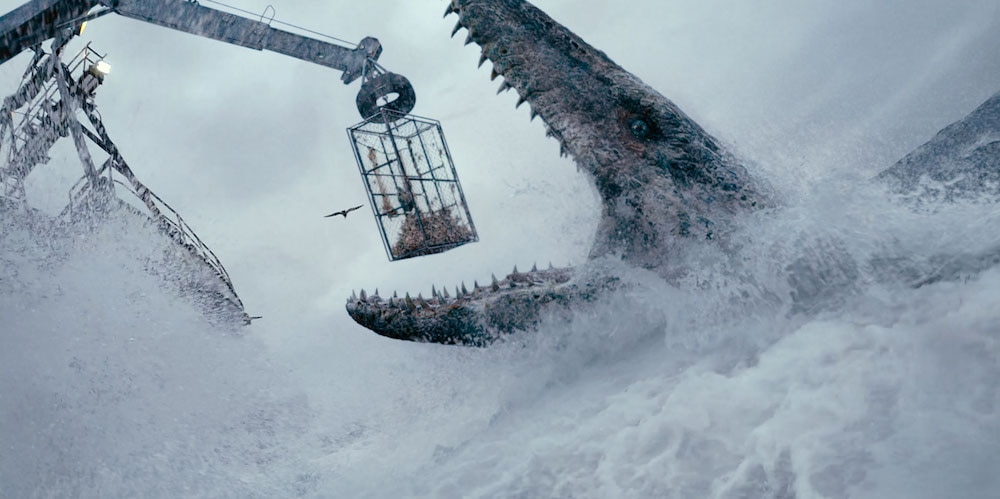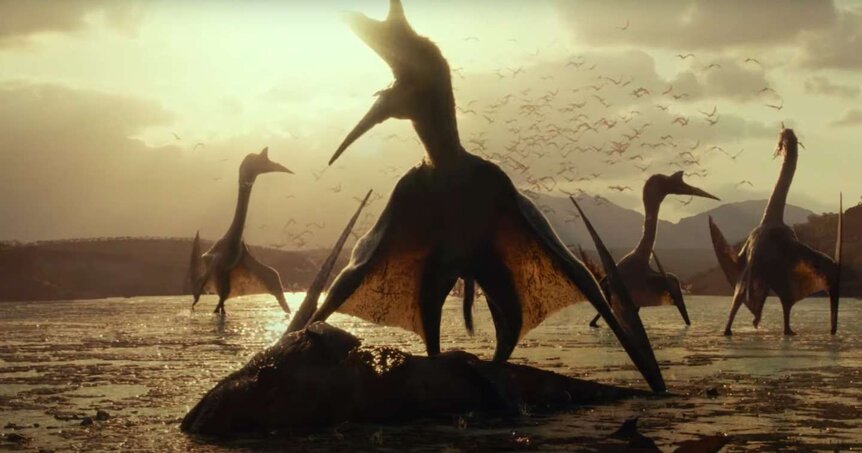Create a free profile to get unlimited access to exclusive videos, sweepstakes, and more!
The 5 coolest dinosaurs in the 'Jurassic Park' and 'Jurassic World' movies
Okay, yes, mosasaurus aren't dinosaurs, but you know what we mean.

Dinosaurs don’t need to be inside Dennis Nedry’s special refrigerated can of shaving cream to be cool. They simply are cool. Three Jurassic Park films and three Jurassic World movies, have proved this fact. There are dozens of dinos across the franchise and all of them are, on some level, extremely cool. If you showed me the lamest dinosaur from the series in real life, I would still think it was one of the coolest things I have ever seen.
Having established that dinosaurs are, in fact, cool, we can now split hairs and try to determine which are the coolest dinosaurs in the six movies. There are five that really stand out, due to a combination of how cool the dinosaurs are in real life and how well they come off in the movie. A couple of notes: First, yes, prehistoric flying and aquatic reptiles are technically not dinosaurs, but they’re eligible for this list.
Second — and this may be controversial — Neither velociraptors nor tyrannosaurus rexes are on this list. If this were a list of the best or most iconic dinosaurs, those two would have the top two spots automatically. However, they’re kind of old hat — like, 65 million years old hat. Both species are somewhat overexposed, making them a little basic and a little less cool. They are still both extremely cool, do not get me wrong. (Please refer back to the first paragraph of this article.) We’re just going to highlight five dinosaurs who, for the most part, had one big standout movie or scene that really wowed.
5. Brachiosaurus
Spoiler alert: The rest of this list is all carnivores. With all due respect to herbivores, eating leaves is, typically, not quite as sick as hunting down prey. However we would be remiss if we didn’t put at least one plant-eater on the list, and the brachiosaurus, the first dinosaur we see in the series, deserves recognition.
There were larger sauropods, some of which would be featured in later Jurassic movies, but the brachiosaurus is still an awe-inspiring, towering animal. It’s this awe-inspiring nature that makes brachiosaurus one of the coolest dinosaurs in the franchise because the entire first movie and everything that came after it work so well because of that first scene, when Alan Grant sees a dinosaur — a real, living dinosaur! — for the first time and is nearly overcome with emotion. Later dinosaur reveals would focus more on terror, and by the time you get to the sequels, some of that magic is gone. That first reveal of the brachiosaurus, a creature so massive it shakes the ground when it walks, perfectly distills just how freaking cool it would be to see a real dinosaur.
And, not for nothing, Jurassic Park probably would’ve been fine if Hammond had stuck to herbivores only.
4. Spinosaurus
There’s a bit of a tryhard quality to Spinosaurus, and as we all know, “trying” is not cool. Introduced in Jurassic Park III as an even bigger and meaner dinosaur than the T. rex, Spinosaurus feels kind of forced — an artificial raising of the stakes. (“Oh, you thought T. rex was bad? Well, Spinosaurus starts off the moving by killing a T. rex!”)
And yet… Spinosaurus is extremely cool. Arguably the largest carnivore ever to walk the earth (scientists debate if it or a handful of other contenders, including the T. rex and appropriately named giganotosaurus, was the biggest), Spinosaurus looks different than a “typical” dinosaur. The sail on its back is imposing, its jaw is long and narrow like a crocodile, and its arms a little beefier than T. rex’s nubs. Jurassic Park III’s problem was that it tried to make spinosaurus cool not on the dinosaur’s own many merits, but at the expense of the beloved T. rex. (There’s a reason why a T. rex smashes through the skeleton of a spinosaurus in Jurassic World in an equally clumsy attempt to even the score.) When appreciated for what it is and not as part of some fossil-measuring contest with the most iconic dinosaur of all time, spinosaurus is indeed cool.
3. Quetzalcoatlus
Bigger doesn’t always mean better, though with dinosaurs, the sheer scale of these animals is a key part of why we’re so fascinated with them. The quetzalcoatlus, which makes its debut in Jurassic World Dominion, is, quite frankly, too big. Thought to have been the largest flying animal that ever existed, the quetzalcoatlus was the size of a small plane with its wings extended. Or, for an even more jarring size comparison, it was about as tall as a giraffe when it “stood” upright on its folded wings.
Imagine looking up at a giraffe, but instead of a cuddly face with dumb little knobby horns munching on acacia leaves, there was a sharp beak twice your height pointed down at you. Then imagine that this thing takes off, defying the laws of gravity to become skyborne under its own power alone. It’s insane, and when one takes down a plane in Dominion, it feels justified. These guys ruled the skies first, after all.
2. Dilophosaurus
Michael Crichton, author of Jurassic Park put a lot of work into creating the most scientifically plausible explanation for how Jurassic Park’s dinosaurs got brought back to life. (It wouldn’t actually work, but in typical Crichton fashion he went far above and beyond trying to make his sci-fi as scientific as possible.) However, when it came to the dilophosaurus, both the book and the film adaptation said “okay, but what if we had fun with it?”
The real dilophosaurus was actually one of the largest predators of its era and would’ve towered over poor Dennis Nedry, and there’s no evidence whatsoever that it had a frill or the ability to spit acid. And yet… thank goodness that scientific accuracy took one for the team because the dilophosaurus attacking Nedry is an incredible scene, and the dinosaur’s fictionalized abilities help it stand out from every other dinosaur attack in the series. While other dinosaurs just slice and bite, dilophosaurus has flare and pizzaz and acid spit.
1. Mosasaurus
Extinct animals are inherently exciting. The past is a place that we will never go to, and as a result, we can only wonder — and let our imaginations run wild — what it would’ve been like to really see these long-gone beasts. Similarly, the ocean is inherently exciting, as although it is possible to take sail or submerge below the waves, it is not where we humans belong. We can’t know, for sure, what might be lurking in the depths. This is why mosasaurus — hulking aquatic reptiles that are akin to whale-sized crocodiles — are so wondrous.
A mosasaurus’ star turn in Jurassic World, followed by briefer but memorable appearances in the next two Jurassic World movies, lives up to this expectation. Sure, it’s introduced as the star of a Sea World-like show, a level of humiliating captivity that is unbefitting such a creature of the deep, but by the end of the movie, it’s clear that this mosasaurus is the baddest creature in the park. It — not the T. rex or velociraptor — has the honor of chowing down on the genetically modified indominus rex. (It’s worth noting that the mosasaurus in the movie is, like, five times bigger than the real animal would’ve been. Scientifically inaccurate, sure, but very cool.)
When the dinosaurs escape into the wider world at the end of Fallen Kingdom, it’s that brief scene of the mosasaurus attacking a fishing trawler that’s the most exciting. Dinosaurs are dinosaurs. They’re incredibly cool animals that once walked the earth but no longer remain. We know on some level that they don’t belong here. Mosasaurus? These are sea monsters. This creature is exactly where it should be, swimming below the waves where we can’t see it until it’s too late.
Jurassic World Dominion opens in theaters on June 10.



























